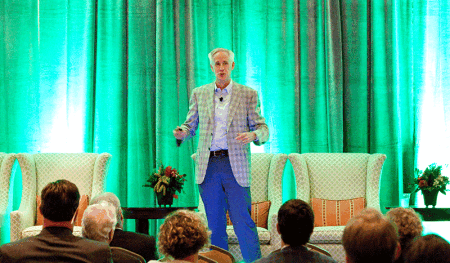In a keynote at ULI South Carolina’s Capital Markets Conference, John Burns, author and CEO of John Burns Real Estate Consulting, explained how changing the way we think about age-based cohorts can help us better understand market trends and predict consumer behavior. (In case anyone with a clipboard asks, Burns is in his early to mid-50s—“officially” a baby boomer, but on the cusp of generation X.)
To illustrate his point, Burns showed a slide with two photographs. On the left was a young Mark Zuckerberg, once a college dropout and now a 34-year-old working father; on the right, a picture of Burns’s own 18-year-old daughter whom he had just dropped off at college. One had been working for years to revolutionize the way we use technology; the other was just getting settled in her freshman dormitory. Both are considered millennials.
“How are you going to have a conversation about millennials when you’re grouping these two high schoolers in the same sentence?” he asked. “You can’t.”
Burns then gave attendees an overview of his best-selling book, Big Shifts Ahead: Demographic Clarity for Businesses, which he coauthored with his firm’s chief demographer, Chris Porter. Before there was a book, Burns said, there were simply questions. (Download presentation.)
“In 2013, the economy was coming back; but real estate was not coming back the way most of us thought it would,” he said. “You’d hear great comments about millennials and gen X and boomers, but there was just one generalization after another.”
Burns knew there had to be an easier, more nuanced way to distinguish generations from one another. He also wanted to tell his clients exactly why the real estate market was taking longer to bounce back. Developers and investors needed to know what segments of the market they should focus on—then and in 10 years. How was social media driving decision-making? How were people feeling about their jobs, and their ability to buy homes? Where did young people want to live? What about retirees? Would people even retire at all?
Porter and a team of interns scoured market data, analyzed trends, and looked for personal stories that would, they say in the book, “communicate the shifts we are facing in a personable, relatable way.” They even surveyed high school reunion-goers about their homeownership rates.
Nine thousand hours, three years, and countless spreadsheets later, Burns and Porter had plenty of answers. They also had enough insights and data charts to publish a 250-plus-page book that has since become a useful forecasting tool for the entire real estate industry.
Burns described how his team created three frameworks for their findings that allowed them to forecast trends over a 10-year period. The first framework, which tied back to Burns’s opening example, established new generational definitions based on the decade in which someone was born (see below).
Those born within a particular decade are grouped and given a name that reflects a predominant societal shift that occurred (or is likely to occur) in their lifetime. For instance, those born in the decade after the Great Depression are called “Savers,” reflecting their judicious spending habits. Skip ahead to the “Innovators,” or those born in the 1950s, such as Bill Gates and Steve Jobs, who led a shift toward technology and entrepreneurship. Those born in the 1990s are “Connectors,” having come of age fluent in technology.
The second framework identified four societal influences that would affect people across five stages of their lives, while the third framework outlined the “4-5-6” rule. This rule considers all of the above in an effort to answer six basic questions related to consumer behavior.
The frameworks—examining data through the lens of major life influencers, across various ages and life stages—allowed Burns and his team to forecast some key “demographic opportunities” they think may emerge between now and 2025. The ones to watch: working women; immigrants; retirees; and young adults born in the 1980s.
In terms of “living preferences,” researchers saw three potential shifts on the horizon: an uptick in rentals over purchased housing; population growth in the “sunshine” states of the South; and a desire for what Burns’s group has coined the surban™ lifestyle, or an “urban-like” environment in the heart of the suburbs. This may include “smaller houses, less yard, some walkability, some access to public transportation,” without the high price tag of city living.
Given that Burns is a demographics expert talking to a roomful of real estate professionals, he spent a good bit of time making connections among the age-based groups and highlighting noteworthy statistics and trends. Using their 4-5-6 rule as a measure, the Burns team saw the highest potential in the following segments: affluent empty nesters; first-time homebuyers in their 30s; the luxury urban market, with a special callout to the professionally managed rental home niche; and seniors aging in place.
When deciding how to best reach a particular demographic, Burns reminded the audience to think about how different age groups engage with technology. Drawing the distinction between his own generation of “Equalers” born in the 1960s and his daughter’s generation of “Connectors” born in the 1990s, Burns laughed: “I don’t think I’ve ever seen my daughter with a dollar bill in her hand. She uses a card for everything.”
He cited data that showed a growing number of young homebuyers using their smartphones to make offers on houses, something an older buyer might be more hesitant to do.
Burns is an altruistic and prolific messenger. His consulting firm conducts an average of 600 studies a year, and he stays busy researching market trends, advising clients, and traveling on the speaking circuit. He is often sought out by media outlets as an expert resource on demographic trends.
By sharing his insights, Burns said he hopes to help real estate professionals “end the guesswork” in their strategic decision-making. “If you can analyze the generations by decade born, it will make your life a lot easier,” he added. “If you can break [your internal] discussions down . . . into this 4-5-6- rule, I promise it’s going to save you time and you’ll invest with a lot more confidence.”







